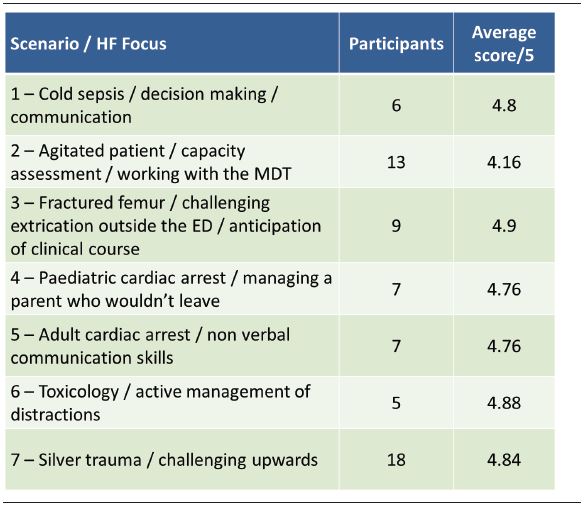
Working in Emergency Departments (ED) can, at times, be challenging for staff who are expected to work as a team, manage a wide range of conditions, and respond rapidly in a changeable environment [1]. Simulation has been proven to be a psychologically safe approach allowing staff to practise and explore Human Factors (HF) skills [2]. WingFactors, HF trained pilots, joined the faculty to collaborate and run in-situ simulation [3]. Our aim was to integrate HF-focused simulation with application into clinical practice, utilising the novel and fresh aviation perspective.
Simulations were designed by clinicians with both technical and non-technical learning outcomes. Patients were played with either a manikin, a pre-briefed actor, or both. The participants were mainly doctors and nurses but have included the wider multidisciplinary team. Senior doctors were embedded and briefed to be able to offer support as part of a staggered entry. After debriefing, each participant completed a feedback form evaluating their experience, confidence levels, and take-home messages.
Seven different scenarios were run gathering 65 responses. Participants’ agreement with five questions using 5-point Likert scales and free text thematic analysis allowed evaluation of the simulation experience. They were asked to consider the usefulness, understanding, and relevance of topics, as well as confidence gained. In addition, participants were asked how they felt the experience would change or enhance their clinical practice. High satisfaction and clinical relevance of the simulations were reported with a mean score of 4.85 across all domains (Table 1). Qualitative feedback showed participants had learnt both technical and specific non-technical learning objectives. Thematic analysis demonstrated that participants had gained skills such as improved emotional intelligence and confidence, ability to challenge authority gradients safely, team motivation, and shared decision-making. Some of the key themes from the feedback offered by the pilots include the importance of ‘read-back’ communication, pressure testing decision-making, and the power of pre-briefing.

 |
The involvement of the pilots added value to the teaching by bringing a new perspective, experience, and application of HF. Individuals have walked away with a better understanding of they can practically implement HF skills into everyday clinical practice, improve patient care and mitigate risk. We hope to progress this collaboration, trialling new HF concepts (e.g. managing error) involving more members, not only the multidisciplinary team, but service users as well and to explore the potential learning in offering more clinicians the patient’s perspective.
1. Bleetman A, Sanusi S, Dale T, Brace S. Human factors and error prevention in emergency medicine. Emerg Med J. 2012;29(5):389–393.
2. Petrosoniak A, Auerbach M, Wong AH, Hicks CM. In situ simulation in emergency medicine: moving beyond the simulation lab. Emergency Medicine Australasia. 2017;29(1):83–88.
3. WingFactors. Pilot Sim Programme. https://wingfactors.co.uk/pilot-sim/ [Accessed on 18/06/2022].